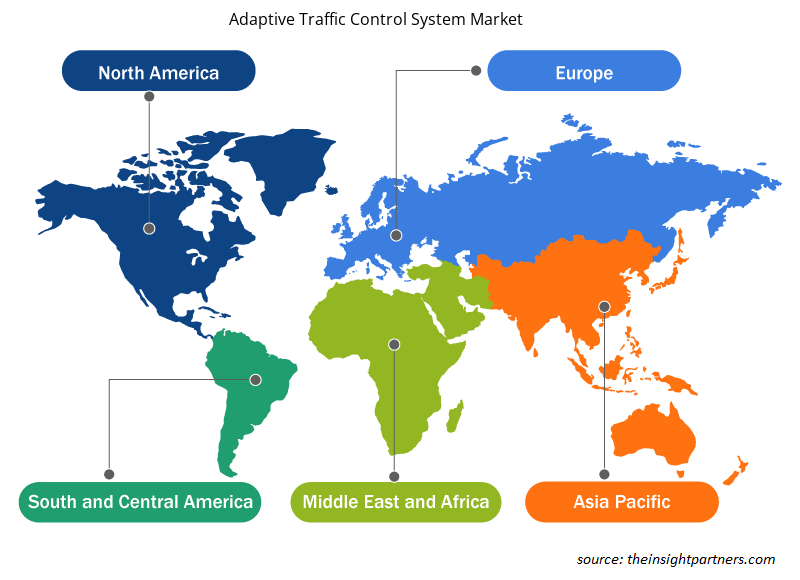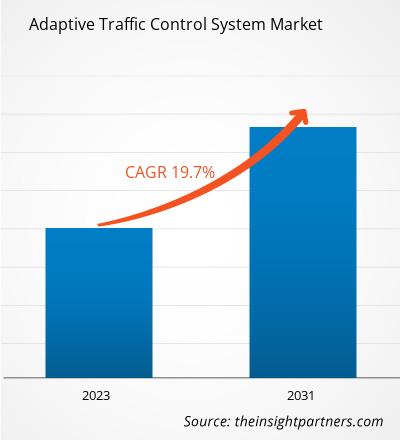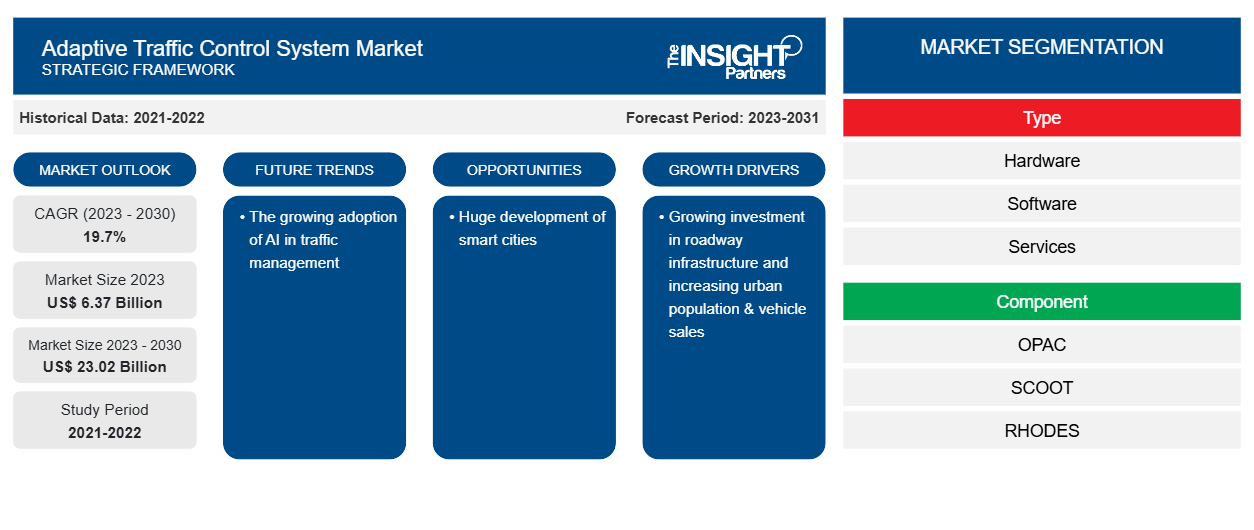من المتوقع أن يصل حجم سوق نظام التحكم في حركة المرور التكيفي إلى 23.02 مليار دولار أمريكي بحلول عام 2030 من 6.37 مليار دولار أمريكي في عام 2023. ومن المتوقع أن يسجل السوق معدل نمو سنوي مركب بنسبة 19.7٪ خلال الفترة 2023-2030. ومن المرجح أن يظل التبني المتزايد للذكاء الاصطناعي في إدارة حركة المرور اتجاهًا رئيسيًا في السوق.
تحليل سوق نظام التحكم في حركة المرور التكيفي
على مدى السنوات القليلة الماضية، شهد سوق نظام التحكم في حركة المرور التكيفي نموًا كبيرًا بسبب عوامل مثل الاستثمار المتزايد في البنية التحتية للطرق وزيادة عدد السكان الحضريين ومبيعات المركبات. التطور الهائل للمدن الذكية يوفر فرص نمو مربحة لسوق نظام التحكم في حركة المرور التكيفي.
نظرة عامة على سوق نظام التحكم في حركة المرور التكيفي
نظام التحكم التكيفي في حركة المرور (ATCS) هو حل يتيح للمدن إدارة إشارات المرور والمشاة جنبًا إلى جنب مع شبكات الطرق المعقدة لتحسين تدفق حركة المرور. يتكيف نظام التحكم التكيفي في حركة المرور مع أنماط حركة المرور في الوقت الفعلي لتحسين تدفق حركة المرور من خلال تغيير توقيتات تقسيم الضوء الأخضر بشكل ديناميكي. بناءً على حجم حركة المرور عند كل تقاطع والعدد المتوقع للوافدين من التقاطعات القريبة، تعمل خوارزمية ATCS على تعديل توقيت إشارات المرور باستمرار. من خلال السماح للسيارات بالمرور تدريجيًا عبر الإشارات الخضراء، فإنه يقلل بشكل كبير من أوقات السفر ويسهل حركة المرور من خلال تعزيز التدفق السلس.
قم بتخصيص هذا التقرير ليناسب متطلباتك
ستحصل على تخصيص لأي تقرير - مجانًا - بما في ذلك أجزاء من هذا التقرير، أو تحليل على مستوى الدولة، وحزمة بيانات Excel، بالإضافة إلى الاستفادة من العروض والخصومات الرائعة للشركات الناشئة والجامعات
- احصل على أهم اتجاهات السوق الرئيسية لهذا التقرير.ستتضمن هذه العينة المجانية تحليلاً للبيانات، بدءًا من اتجاهات السوق وحتى التقديرات والتوقعات.
محركات وفرص سوق أنظمة التحكم في حركة المرور التكيفية
زيادة الاستثمار في البنية التحتية للطرق لصالح السوق
يتزايد الطلب على مرافق نقل أفضل، مثل تحسين ظروف الطرق، وتدفق حركة المرور السلس، والاتصال بين المناطق المختلفة، في جميع أنحاء العالم بسبب الزيادة السكانية. ونتيجة لذلك، تركز السلطات الحكومية في مختلف البلدان على تطوير البنية التحتية للطرق. في يونيو 2022، أعلنت حكومة الصين عن خطتها لإطلاق 120 طريقًا سريعًا جديدًا ومشاريع طرق سريعة وطنية وإقليمية عادية، والتي ستغطي أكثر من 3600 كيلومتر. سيتم تخصيص مبلغ إجمالي قدره 27.20 مليار دولار أمريكي (182 مليار يوان) لهذه المشاريع. وبالمثل، في مارس 2022، أعلنت شركة VINCI Highways أن توسيع طريق B247 بين مولهاوزن وباد لانجينسالزا في ألمانيا قد بدأ. لبناء هذا الطريق، وافقت الحكومة على استثمار بقيمة ~ 545.61 مليون دولار أمريكي (500 مليون يورو). كما أعلنت حكومة أونتاريو عن استثمار بقيمة 3 مليارات دولار أمريكي لإصلاح وتوسيع الطرق السريعة والجسور الإقليمية من أبريل 2022 إلى مارس 2023. تم استخدام ما يقرب من 1.7 مليار دولار أمريكي في جنوب أونتاريو وحوالي 624 مليون دولار أمريكي في شمال أونتاريو لإصلاح وتوسيع الطرق السريعة والجسور. تزيد الاستثمارات المتزايدة في البنية التحتية للطرق من الحاجة إلى تنفيذ أنظمة التحكم الآلي في حركة المرور لتحسين تدفق حركة المرور وتعزيز سلامة المركبات. وبالتالي، فإن الإنفاق المتزايد على البنية التحتية لسلامة الركاب والسائقين يعزز نمو سوق نظام التحكم التكيفي في حركة المرور.
تزايد استخدام الذكاء الاصطناعي في إدارة المرور
لقد خضعت إدارة حركة المرور على الطرق لتحول جذري نتيجة للتطور السريع للذكاء الاصطناعي. في هذه الأيام، يمكن للذكاء الاصطناعي التنبؤ بدقة وإدارة حركة الأشخاص والأشياء والسيارات والبضائع في مواقع مختلفة على طول شبكة النقل. لا يقدم الذكاء الاصطناعي للمواطنين خدمات أفضل من ذي قبل فحسب، بل إنه يتيح أيضًا أوقات سفر أكثر أمانًا في الأوقات التي تُغلق فيها الطرق بسبب أعمال البناء أو الأحداث الأخرى ويقلل من عدد الحوادث من خلال تحسين أنماط المرور عند التقاطعات. علاوة على ذلك، فإن قدرة الذكاء الاصطناعي على التعامل مع كميات هائلة من البيانات وتقييمها جعلت خدمات مشاركة الرحلات المشابهة للنقل الجماعي فعالة.
تقرير تحليل تجزئة سوق نظام التحكم في حركة المرور التكيفي
إن القطاعات الرئيسية التي ساهمت في اشتقاق تحليل سوق نظام التحكم التكيفي في حركة المرور هي النوع والمكونات والتطبيق.
- وفقًا للنوع، ينقسم سوق أنظمة التحكم في حركة المرور التكيفية إلى أجهزة وبرامج وخدمات. ومن المتوقع أن يستحوذ قطاع الأجهزة على حصة سوقية كبيرة في عام 2022.
- بحسب المكونات، يتم تقسيم السوق إلى OPAC وSCOOT وRHODES وSCATS. احتل قطاع SCATS أكبر حصة سوقية في عام 2022.
- من حيث التطبيق، تم تقسيم السوق إلى الطرق السريعة والمدن الحضرية. احتلت شريحة المدن الحضرية الحصة الأكبر في السوق في عام 2022.
تحليل حصة سوق نظام التحكم في حركة المرور التكيفي حسب المنطقة الجغرافية
ينقسم النطاق الجغرافي لتقرير سوق نظام التحكم في حركة المرور التكيفي بشكل أساسي إلى خمس مناطق: أمريكا الشمالية، وآسيا والمحيط الهادئ، وأوروبا، والشرق الأوسط وأفريقيا، وأمريكا الجنوبية والوسطى.
تُستخدم أنظمة التحكم في حركة المرور التكيفية على نطاق واسع في المملكة المتحدة وآسيا وأستراليا. أقل من 1% من التقاطعات التي تعمل بإشارات ضوئية في الولايات المتحدة بها تقنيات التحكم في إشارات المرور التكيفية. بالإضافة إلى التكلفة المحتملة للأجهزة، فإن العقبات الأخرى، مثل المعرفة المطلوبة لتكوين النظام وصيانته، وغياب قياس الأداء النشط، والمفاهيم الخاطئة فيما يتعلق بمزايا تقنية التحكم في إشارات المرور التكيفية قد تحد من تبني أنظمة التحكم في حركة المرور التكيفية في بلدان مختلفة.
رؤى إقليمية حول سوق أنظمة التحكم في حركة المرور التكيفية
لقد قام المحللون في Insight Partners بشرح الاتجاهات والعوامل الإقليمية المؤثرة على سوق نظام التحكم في حركة المرور التكيفي طوال فترة التنبؤ بشكل شامل. يناقش هذا القسم أيضًا قطاعات سوق نظام التحكم في حركة المرور التكيفي والجغرافيا في جميع أنحاء أمريكا الشمالية وأوروبا ومنطقة آسيا والمحيط الهادئ والشرق الأوسط وأفريقيا وأمريكا الجنوبية والوسطى.

- احصل على البيانات الإقليمية المحددة لسوق نظام التحكم في حركة المرور التكيفي
نطاق تقرير سوق نظام التحكم في حركة المرور التكيفية
| سمة التقرير | تفاصيل |
|---|---|
| حجم السوق في عام 2023 | 6.37 مليار دولار أمريكي |
| حجم السوق بحلول عام 2030 | 23.02 مليار دولار أمريكي |
| معدل النمو السنوي المركب العالمي (2023 - 2030) | 19.7% |
| البيانات التاريخية | 2021-2022 |
| فترة التنبؤ | 2023-2031 |
| القطاعات المغطاة | حسب النوع
|
| المناطق والدول المغطاة | أمريكا الشمالية
|
| قادة السوق وملفات تعريف الشركات الرئيسية |
|
كثافة اللاعبين في سوق نظام التحكم في حركة المرور التكيفي: فهم تأثيره على ديناميكيات الأعمال
يشهد سوق أنظمة التحكم في حركة المرور التكيفية نموًا سريعًا، مدفوعًا بالطلب المتزايد من المستخدم النهائي بسبب عوامل مثل تفضيلات المستهلكين المتطورة والتقدم التكنولوجي والوعي المتزايد بفوائد المنتج. ومع ارتفاع الطلب، تعمل الشركات على توسيع عروضها والابتكار لتلبية احتياجات المستهلكين والاستفادة من الاتجاهات الناشئة، مما يؤدي إلى زيادة نمو السوق.
تشير كثافة اللاعبين في السوق إلى توزيع الشركات أو المؤسسات العاملة في سوق أو صناعة معينة. وهي تشير إلى عدد المنافسين (اللاعبين في السوق) الموجودين في مساحة سوق معينة نسبة إلى حجمها أو قيمتها السوقية الإجمالية.
الشركات الرئيسية العاملة في سوق نظام التحكم في حركة المرور التكيفية هي:
- شركة ألدريدج للتحكم في حركة المرور المحدودة
- ديجيكون إس إيه
- شركة EFKON الهندية المحدودة
- شركة إفترونيكس سيستمز المحدودة
- شركة كابش ترافيك كوم ايه جي
- شركة ترافيكسول آي تي إس تكنولوجيز المحدودة
إخلاء المسؤولية : الشركات المذكورة أعلاه ليست مرتبة بأي ترتيب معين.

- احصل على نظرة عامة على أهم اللاعبين الرئيسيين في سوق نظام التحكم في حركة المرور التكيفي
أخبار السوق والتطورات الأخيرة لنظام التحكم في حركة المرور التكيفي
يتم تقييم سوق نظام التحكم في حركة المرور التكيفي من خلال جمع البيانات النوعية والكمية بعد البحث الأولي والثانوي، والذي يتضمن منشورات الشركات المهمة وبيانات الجمعيات وقواعد البيانات. فيما يلي بعض التطورات في سوق نظام التحكم في حركة المرور التكيفي:
- أعلنت شركة Yunex Traffic عن إطلاق منصة Yutraffic Blade Advanced Traffic Controller في السوق الأمريكية. تحتوي وحدة التحكم في الحوسبة الطرفية من الجيل التالي على معالج ثنائي النواة، قوي بما يكفي لجميع تطبيقات التحكم في حركة المرور اليوم وجاهز لتطبيقات المستقبل. (المصدر: Yunex Traffic، بيان صحفي، أبريل 2023)
- بدأت مديرية النقل البري الحضري (DULT) التشغيل التجريبي لنظام إشارات المرور الجديد عند تقاطع طريق كنسينغتون وطريق مورفي بالقرب من أولسور. يشتمل النظام على تقنية MODERATO اليابانية (إدارة التكيف المرتبط بالأصل والوجهة لتحسين حركة المرور). (المصدر: THE HINDU BUREAU، بيان صحفي، فبراير 2024)
تقرير سوق نظام التحكم في حركة المرور التكيفي: التغطية والنتائج المتوقعة
يوفر تقرير "حجم سوق نظام التحكم في حركة المرور التكيفي والتوقعات (2020-2030)" تحليلاً مفصلاً للسوق يغطي المجالات التالية:
- حجم سوق نظام التحكم في حركة المرور التكيفي والتوقعات على المستويات العالمية والإقليمية والوطنية لجميع قطاعات السوق الرئيسية التي يغطيها النطاق
- اتجاهات سوق نظام التحكم في حركة المرور التكيفي، بالإضافة إلى ديناميكيات السوق مثل السائقين، والقيود، والفرص الرئيسية
- تحليل مفصل لقوى PEST/Porter الخمس وSWOT
- تحليل سوق نظام التحكم في حركة المرور التكيفي الذي يغطي اتجاهات السوق الرئيسية والإطار العالمي والإقليمي والجهات الفاعلة الرئيسية واللوائح والتطورات الأخيرة في السوق
- تحليل المشهد الصناعي والمنافسة الذي يغطي تركيز السوق، وتحليل خريطة الحرارة، واللاعبين البارزين، والتطورات الأخيرة لسوق نظام التحكم في حركة المرور التكيفي
- ملفات تعريف الشركة التفصيلية
- التحليل التاريخي (سنتان)، سنة الأساس، التوقعات (7 سنوات) مع معدل النمو السنوي المركب
- تحليل PEST و SWOT
- حجم السوق والقيمة / الحجم - عالمي، إقليمي، بلد
- الصناعة والمنافسة
- مجموعة بيانات إكسل
التقارير الحديثة
شهادات العملاء
سبب الشراء
- اتخاذ قرارات مدروسة
- فهم ديناميكيات السوق
- تحليل المنافسة
- رؤى العملاء
- توقعات السوق
- تخفيف المخاطر
- التخطيط الاستراتيجي
- مبررات الاستثمار
- تحديد الأسواق الناشئة
- تحسين استراتيجيات التسويق
- تعزيز الكفاءة التشغيلية
- مواكبة التوجهات التنظيمية





















 احصل على عينة مجانية ل - سوق أنظمة التحكم في حركة المرور التكيفية
احصل على عينة مجانية ل - سوق أنظمة التحكم في حركة المرور التكيفية